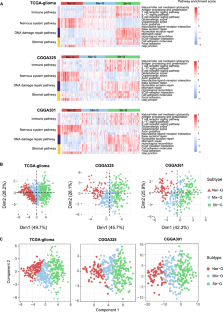Interdisciplinary Sciences: Computational Life Sciences ( IF 4.8 ) Pub Date : 2024-04-18 , DOI: 10.1007/s12539-024-00627-w Qiushi Feng , Zehua Dong , Rongfang Nie , Xiaosheng Wang

|
Gliomas are highly heterogeneous in molecular, histology, and microenvironment. However, a classification of gliomas by integrating different tumor microenvironment (TME) components remains unexplored. Based on the enrichment scores of 17 pathways involved in immune, stromal, DNA repair, and nervous system signatures in diffuse gliomas, we performed consensus clustering to uncover novel subtypes of gliomas. Consistently in three glioma datasets (TCGA-glioma, CGGA325, and CGGA301), we identified three subtypes: Stromal-enriched (Str-G), Nerve-enriched (Ner-G), and mixed (Mix-G). Ner-G was charactered by low immune infiltration levels, stromal contents, tumor mutation burden, copy number alterations, DNA repair activity, cell proliferation, epithelial-mesenchymal transformation, stemness, intratumor heterogeneity, androgen receptor expression and EGFR, PTEN, NF1 and MUC16 mutation rates, while high enrichment of neurons and nervous system pathways, and high tumor purity, estrogen receptor expression, IDH1 and CIC mutation rates, temozolomide response rate and overall and disease-free survival rates. In contrast, Str-G displayed contrastive characteristics to Ner-G. Our analysis indicates that the heterogeneity between glioma cells and neurons is lower than that between glioma cells and immune and stromal cells. Furthermore, the abundance of neurons is positively associated with clinical outcomes in gliomas, while the enrichment of immune and stromal cells has a negative association with them. Our classification method provides new insights into the tumor biology of gliomas, as well as clinical implications for the precise management of this disease.
Graphic Abstract
中文翻译:

基于通路富集评估识别弥漫性胶质瘤亚型
胶质瘤在分子、组织学和微环境方面具有高度异质性。然而,通过整合不同肿瘤微环境(TME)成分对神经胶质瘤进行分类仍有待探索。基于弥漫性神经胶质瘤中涉及免疫、基质、DNA 修复和神经系统特征的 17 条通路的富集分数,我们进行了共识聚类,以发现神经胶质瘤的新亚型。在三个神经胶质瘤数据集中(TCGA-神经胶质瘤、CGGA325 和 CGGA301),我们一致地确定了三种亚型:基质丰富型 (Str-G)、神经丰富型 (Ner-G) 和混合型 (Mix-G)。 Ner-G 的特点是免疫浸润水平低、基质内容物、肿瘤突变负荷、拷贝数改变、DNA 修复活性、细胞增殖、上皮间质转化、干性、肿瘤内异质性、雄激素受体表达以及EGFR、PTEN、NF1和MUC16突变率,同时神经元和神经系统通路的高度富集,以及高肿瘤纯度、雌激素受体表达、IDH1和CIC突变率、替莫唑胺反应率以及总体和无病生存率。相比之下,Str-G 表现出与 Ner-G 相反的特征。我们的分析表明,神经胶质瘤细胞和神经元之间的异质性低于神经胶质瘤细胞与免疫细胞和基质细胞之间的异质性。此外,神经元的丰富度与神经胶质瘤的临床结果呈正相关,而免疫细胞和基质细胞的富集则与之呈负相关。我们的分类方法为神经胶质瘤的肿瘤生物学提供了新的见解,以及对该疾病的精确管理的临床意义。



























 京公网安备 11010802027423号
京公网安备 11010802027423号